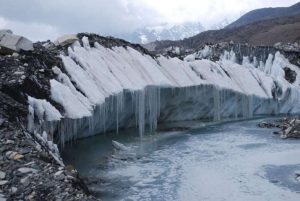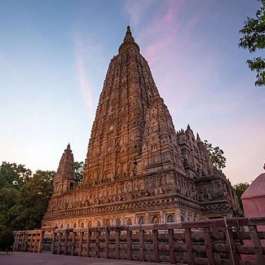
Buddhist scholar and journalist Deepak Anand, who has undertaken a daring 2,200-kilometer overland pilgrimage to retrace the footsteps in India and Nepal of the influential seventh-century Chinese Buddhist monk, scholar, and translator Xuanzang—a project known as “Retracing Bodhisattva Xuanzang”*—has announced plans to produce a documentary video series inspired by his travels, which will focus on the sublime wanderings of the historical Buddha, Shakyamuni and, subsequently, by Master Xuanxang.
“Our proposal is to make a documentary series focusing on ‘The Sublime Wanderings of the Buddha,’ or Buddha-carika, with a new perspective on ‘Places, Routes and Rituals,’ as elucidated in the descriptions of the seventh-century monk-scholar Xuanzang. We will divide the Buddha-carika into 16 thematic stories or episodes,” Anand shared with Buddhistdoor Global.
Through his own pilgrimage, Anand, a researcher at Nava Nalanda Mahavihara University, has sought to raise awareness of some of the lesser known jewels of India’s vast Buddhist heritage, as well as the formidable and far-reaching legacy of Master Xuanzang himself, the influences of which are still felt to this day.
“This pilgrimage is currently limited to the eight great places associated with the Buddha: Bodh Gaya, Kushinagar, Lumbini, Rajgir, Sankissa, Sarnath, Shravasti, and Vaishali,” Anand explained. “But ancient Buddhist literature, especially the travelogue of Master Xuanzang, elucidates on a very elaborate Buddhist pilgrimage that was not only limited to these eight sites, but included many lesser known places associated with the Buddha and his important disciples.”

Xuanzang (602–64) is widely acknowledged as one of the most illustrious figures in Buddhist history, noted for translating a wealth of Buddhist scriptures from Sanskrit into Chinese, and for embarking on a 17-year overland pilgrimage from China to India (which also took him into what is now Bangladesh, Nepal, and Pakistan), where he lived for more than 13 years. Xuanzang’s time in India included five years at the ancient monastic university of Nalanda, a great center of Buddhist learning, where he acquired knowledge of Sanskrit, Buddhist philosophy, and Indian thought.
While the majority of Xuanzang’s sojourn in India was spent at Nalanda, he traveled widely, visiting every known sacred site connected with the life of the Buddha. It is this aspect of the master’s legacy that Deepak has highlighted and replicated, seeking out sacred sites and historic relics spread across some 15 India states.
Anand’s journey to explore the sublime foodsteps of the Buddha across Indo-Gangetic Plain, is based on fresh interpretations of the travel accounts of Master Xuanzang. The journey began in February 2020 and has to date spanned 2,200 kilometers, with 36 project accounts documenting the sacred sites visited on his blog, Nālandā – Insatiable in Offering.
“The Retracing Bodhisattva Xuanzang foot journey project started in February 2020 from an important Buddhist Site in Haryana, which was part of the ancient Kuru Kingdom in the time of Buddha,” Anand related. “The foot journey project had to stop and was deferred from time to time because of COVID lockdowns, yet by July 2021 we had covered all eight great places of Buddhist pilgrimage and a huge number of other sites connected with the life and the teachings of the Buddha.
“This foot journey has also helped us identify ancient routes connecting these scared places. A revival of these walking pilgrimage trails will help to revitalize the ancient tradition of cetiya carika [Buddhist walking pilgrimage].”
Upon his return to China in 645, Xuanzang retired to a monastery, devoting his energies to translating Buddhist texts into Chinese until his death in 664. According to one biography, Xuanzang returned from India with “over 600 Mahayana and Hinayana texts, seven statues of the Buddha, and more than 100 sarira relics.” (Strong 2004, 188) A detailed account of Xuanzang’s journey is recorded in the classic Chinese narrative Great Tang Records on the Western Regions (compiled in 646), which later formed the basis of the allegorical epic Journey to the West, by the Ming dynasty writer and poet Wu Cheng’en (c. 1500–82).
“The proposed documentary series project is a historical mission and a social impact campaign with a four-dimensional approach,” said Anand:
- To showcase Master Xuanzang’s elaborate pilgrimage by incorporating a large number of lesser known Buddhist shrines in the vicinity of the principal shrines of the eight great places—Master Xuanzang mentions many such shrines;
- To showcase the contributions of Emperor Ashoka and subsequent kings in the development of the Buddhist pilgrimage;
- To showcase the important role of Master Xuanzang in preserving the sacred geography of the footsteps of the Buddha on the Indo-Gangetic Plains. Master Xuanzang’s travelogue is the single most important resource for reconstructing the pilgrimage and identifying sacred places associated with the Buddha. Despite these contributions, Xuanzang is not widely recognized in this connection, and the documentary series can garner due recognition for this important contribution;
- To showcase potential thematic walking pilgrimage trails connecting Buddhist sites and shrines identified during the Retracing Bodhisattva Xuanzang project.

“One of the major findings during the project is the sad and very neglected situation of satellite sites in the vicinity of principal sites such as Bodh Gaya, Lumbini, Sarnath, Shravasti, and Vaishali. Most of these sites are unprotected and local people are totally ignorant about their significance,” Anand emphasized. “There is an urgent need to make documentary films highlighting the situation of these most sacred sites. Most of the stupa remains are neglected and encroached upon, thereby threatening their very existence. Documentary films can become a very powerful medium in the present times to sensitize stakeholders and facilitate their long-term participation in the process of preservation and protection.”
* Sublime Wanderings: Rediscovering the Buddha in the Footsteps of Xuanzang (Buddhistdoor Global)
References
Strong, John. 2004. Relics of the Buddha. Princeton University Press.
See more
Nālandā – Insatiable in Offering
Deepak Anand (Facebook)
Retracing Bodhisattva Xuanzang (Facebook)
The Sublime Wanderings of the Buddha (Vimeo)
The Sublime Wanderings of the Buddha (YouTube)
Retracing Bodhisattva Xuanzang (Traditional Chinese) (YouTube)
Related news reports from Buddhistdoor Global
Archaeologists in China Unearth Sutra Translation by Tang Dynasty Monk Xuanzang
Archaeological Survey of India to Retrace the Footsteps of Chinese Buddhist Missionaries
China Picks Xuan Zang Epic on Eminent Buddhist Monk as Oscar Contender
Related features from Buddhistdoor Global
Sublime Wanderings: Rediscovering the Buddha in the Footsteps of Xuanzang
Buddhistdoor View: Buddhist Hopes for China’s Silk Road Initiative
The Xuanzang Memorial: Evoking China and India’s Buddhist Past and Future
Another Characteristic of Faith in Buddhism: Inheritance














